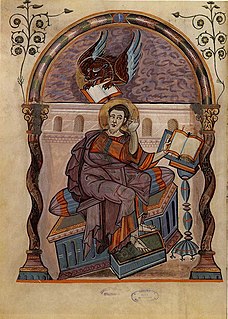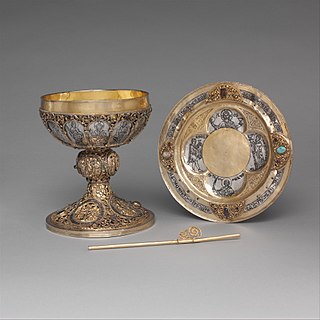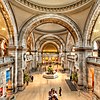
The Lindisfarne Gospels is an illuminated manuscript gospel book probably produced around the years 715-720 in the monastery at Lindisfarne, off the coast of Northumberland, which is now in the British Library in London. The manuscript is one of the finest works in the unique style of Hiberno-Saxon or Insular art, combining Mediterranean, Anglo-Saxon and Celtic elements.

An illuminated manuscript is a manuscript in which the text is supplemented with such decoration as initials, borders (marginalia) and miniature illustrations. In the strictest definition, the term refers only to manuscripts decorated with either gold or silver; but in both common usage and modern scholarship, the term refers to any decorated or illustrated manuscript from Western traditions. Comparable Far Eastern and Mesoamerican works are described as painted. Islamic manuscripts may be referred to as illuminated, illustrated or painted, though using essentially the same techniques as Western works.

The Book of Kells is an illuminated manuscript Gospel book in Latin, containing the four Gospels of the New Testament together with various prefatory texts and tables. It was created in a Columban monastery in either Britain or Ireland and may have had contributions from various Columban institutions from both Britain and Ireland. It is believed to have been created c. 800 AD. The text of the Gospels is largely drawn from the Vulgate, although it also includes several passages drawn from the earlier versions of the Bible known as the Vetus Latina. It is a masterwork of Western calligraphy and represents the pinnacle of Insular illumination. It is also widely regarded as Ireland's finest national treasure.

The Book of Durrow is a medieval illuminated manuscript gospel book in the Insular script style. It was probably created between 650 and 700. The place of creation may perhaps have been Durrow Abbey in Ireland or a monastery in Northumbria in northeastern England or perhaps Iona Abbey in western Scotland—the place of origin has been debated by historians for decades without a consensus emerging. The Book of Durrow was probably at Durrow Abbey by 916. Today it is in the Library of Trinity College, Dublin.

The Gospel Book, Evangelion, or Book of the Gospels is a codex or bound volume containing one or more of the four Gospels of the Christian New Testament – normally all four – centering on the life of Jesus of Nazareth and the roots of the Christian faith. The term is also used of the liturgical book, also called the Evangeliary, from which are read the portions of the Gospels used in the Mass and other services, arranged according to the order of the liturgical calendar.
Mule is a style of shoe that has no back or constraint around the foot's heel. Mules have a history going as back as Ancient Rome, even though they were not popularly worn until sixteenth century Europe. There, mules were bedroom slippers and not worn out in public. Throughout the centuries mules have changed in style and purpose. They are no longer just boudoir shoes and are now worn any day and any occasion. In addition to Western examples, mules come from additional cultures like Turkey and Egypt. Across cultures and time frames, mules appear in popular culture from famous paintings to iconic celebrity shoes.

A cumdach or book shrine is an elaborate ornamented box or case used as a reliquary to enshrine books regarded as relics of the saints who had used them in Early Medieval Ireland. They are normally later than the book they contain, often by several centuries, typically the book comes from the heroic age of Irish monasticism before 800, and the surviving cumdachs date from after 1000, although it is clear the form dates from considerably earlier. Several were then considerably reworked in the Gothic period. The usual form is a design based on a cross on the main face, with use of large gems of rock crystal or other semi-precious stones, leaving the spaces between the arms of the cross for more varied decoration. Several were carried on a chain or cord, often suspended round the neck, which by placing them next to the heart was believed to bring spiritual and perhaps medical benefits. They were also used to witness contracts. Many had hereditary lay keepers from among the chiefly families who had formed links with monasteries. Most surviving examples are now in the National Museum of Ireland ("NMI").

A mantua is an article of women's clothing worn in the late 17th century and 18th century. Originally a loose gown, the later mantua was an overgown or robe typically worn over stays, stomacher and a co-ordinating petticoat.

Evangelist portraits are a specific type of miniature included in ancient and mediaeval illuminated manuscript Gospel Books, and later in Bibles and other books, as well as other media. Each Gospel of the Four Evangelists, the books of Matthew, Mark, Luke, and John, may be prefaced by a portrait of the Evangelist, usually occupying a full page. Their symbols may be shown with them, or separately. Often they are the only figurative illumination in the manuscript. They are a common feature in larger Gospel Books from the earliest examples in the 6th century until the decline of that format for illustrated books in the High Middle Ages, by which time their conventions were being used for portraits of other authors.

Celtic art is associated with the peoples known as Celts; those who spoke the Celtic languages in Europe from pre-history through to the modern period, as well as the art of ancient peoples whose language is uncertain, but have cultural and stylistic similarities with speakers of Celtic languages.

Anglo-Saxon art covers art produced within the Anglo-Saxon period of English history, beginning with the Migration period style that the Anglo-Saxons brought with them from the continent in the 5th century, and ending in 1066 with the Norman Conquest of a large Anglo-Saxon nation-state whose sophisticated art was influential in much of northern Europe. The two periods of outstanding achievement were the 7th and 8th centuries, with the metalwork and jewellery from Sutton Hoo and a series of magnificent illuminated manuscripts, and the final period after about 950, when there was a revival of English culture after the end of the Viking invasions. By the time of the Conquest the move to the Romanesque style is nearly complete. The important artistic centres, in so far as these can be established, were concentrated in the extremities of England, in Northumbria, especially in the early period, and Wessex and Kent near the south coast.

A treasure binding or jewelled bookbinding is a luxurious book cover using metalwork in gold or silver, jewels or ivory, perhaps in addition to more usual bookbinding material for book-covers such as leather, velvet, or other cloth. The actual bookbinding technique is the same as for other medieval books, with the folios, normally of vellum, stitched together and bound to wooden cover boards. The metal furnishings of the treasure binding are then fixed, normally by tacks, onto these boards. Treasure bindings appear to have existed from at least Late Antiquity, though there are no surviving examples from so early, and Early Medieval examples are very rare. They were less used by the end of the Middle Ages, but a few continued to be produced in the West even up to the present day, and many more in areas where Eastern Orthodoxy predominated. The bindings were mainly used on grand illuminated manuscripts, especially gospel books designed for the altar and use in church services, rather than study in the library.

Saint Herlindis, sister of Saint Relindis, was a Frankish saint and abbess.

The Gospel in Christian liturgy refers to a reading from the Gospels used during various religious services, including Mass or Divine Liturgy (Eucharist). In many Christian churches, all present stand when a passage from one of the Gospels is read publicly, and sit when a passage from a different part of the Bible is read. The reading of the Gospels, often contained in a liturgical edition containing only the four Gospels, is traditionally done by a minister, priest or deacon, and in many traditions the Gospel Book is brought into the midst of the congregation to be read.

Insular art, also known as Hiberno-Saxon art, is the style of art produced in the post-Roman history of Ireland and Britain. The term derives from insula, the Latin term for "island"; in this period Britain and Ireland shared a largely common style different from that of the rest of Europe. Art historians usually group insular art as part of the Migration Period art movement as well as Early Medieval Western art, and it is the combination of these two traditions that gives the style its special character.

Falnama is a book of omens used by fortune tellers in Iran and Turkey during the 16th and 17th centuries. Individuals seeking insight into the future would engage in a series of purification rituals, turn to a random page in the Falnama, and interpret the text and drawings thereon for good or ill. Falnama manuscripts were primarily created during the 16th and 17th centuries as the Islamic calendar was approaching the year 1000.

The Metropolitan Museum of Art possesses a collection of items used for the celebration of the Eucharist. The ensemble, which includes a paten, a chalice, and a straw, is currently on display at The Cloisters.

The Metropolitan Museum of Art holds in its collection a number of items attributed to famed 18th century french metalworker François Thomas Germain. Among these items is a silver coffee pot dated to 1757. The pot, a surviving example of french rococo dining ware, is currently on view at The Met Fifth Avenue in Gallery 545.

Hiawath is a 19th century sculpture executed in marble by American sculptor Augustus Saint-Gaudens. The work, which depicts the Iroquois leader Hiawatha, is in the collection of the Metropolitan Museum of Art.

The Metropolitan Museum of Art holds in its collection an Armenian reliquary cross dating to the 18th century. Crafted from a variety of valuable materiel, the cross was made for the Monastery of St. George at Lim in Western Armenia. The piece is inscribed with a warning, reading "Whoever dares to give it [the relic] as a pledge or take it away from Saint George, let them incur his vengeance."

























